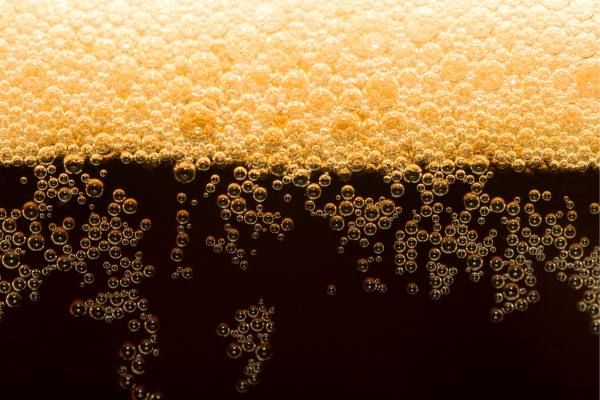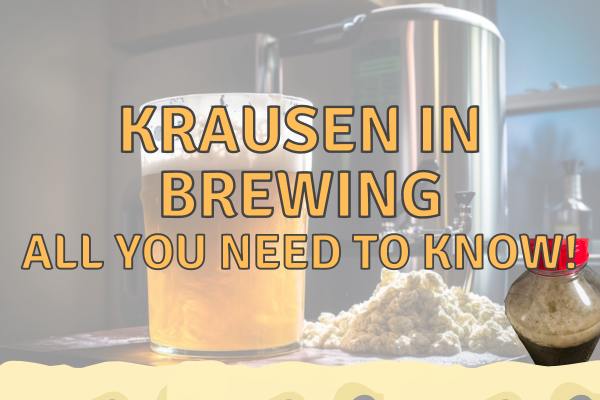Why is beer carbonated and wine not? This question has puzzled many people for ages, particularly those who enjoy both beverages.
At first glance, it might seem like a simple difference in preference or tradition, but there is actually quite a bit of science and history behind this distinction.
In this blog post, I will dive into the fascinating world of fermentation, carbonation, and the historical and cultural reasons behind the difference in carbonation levels between beer and wine. Grab a drink, and let’s get started!
The Science of Fermentation
Fermentation Basics
Fermentation is the process by which yeast consumes sugar and produces alcohol and carbon dioxide. This process occurs naturally in both beer and wine production, as well as in other alcoholic beverages like cider and mead. Yeast is a naturally occurring microorganism that can be found in the air, on the skins of fruit, and even in the wild.
Differences in Fermentation
The fermentation process for beer and wine is quite different, which is one of the reasons behind the difference in carbonation levels.
Beer fermentation typically takes place in a closed system, usually a fermenter with an airlock that allows the escape of carbon dioxide while keeping oxygen out. This closed system helps to retain the carbon dioxide produced during fermentation, leading to a naturally carbonated beverage.
In contrast, wine fermentation generally occurs in an open system, often in large vats or barrels, which allows the carbon dioxide to escape freely. This means that wine does not retain the same level of carbonation as beer does.
The Role of Carbonation in Beer

Enhancing Flavor and Mouthfeel
Carbonation plays an essential role in beer, as it not only enhances the flavor but also contributes to the overall mouthfeel of the beverage.
Carbon dioxide dissolves into the beer, creating carbonic acid, which adds a slight tanginess and sharpness to the taste. The bubbles formed by carbonation also help to release volatile aroma compounds, which contribute to the overall flavor of the beer.
Preserving Freshness
Carbonation also helps to preserve the freshness of beer. Carbon dioxide is a natural preservative, which can help to protect the beer from spoilage and oxidation. This is particularly important for hoppy beers like IPAs, as the hop compounds can degrade quickly and negatively affect the taste of the beer.
The Role of Carbonation in Wine
Carbonation in Sparkling Wines
While most wines are not carbonated, there are some notable exceptions, such as Champagne and other sparkling wines. These wines undergo a secondary fermentation process, often in the bottle, which traps carbon dioxide and creates the characteristic fizziness. The carbonation in sparkling wines adds a refreshing, lively quality that is much sought after by wine enthusiasts.
Still Wines and Carbonation
For most still wines, however, carbonation is considered undesirable. Carbonation can create a sense of acidity or sharpness in the wine, which can clash with the more delicate and subtle flavors found in many wines. Additionally, carbon dioxide can mask certain aroma compounds, which are essential to the overall taste and enjoyment of wine.
Historical and Cultural Factors
Beer Brewing Traditions
Carbonation in beer can be traced back to the ancient Sumerians, who brewed beer in closed clay pots, allowing for the natural carbonation process to occur. This tradition continued throughout history, with brewers in medieval Europe and early America also utilizing closed fermentation systems to produce carbonated beer.
Wine-Making Traditions
In contrast, the tradition of wine-making has always leaned towards still wines. This is likely due to the fact that wine was often made in large quantities, stored in open barrels, and consumed relatively quickly. The lack of carbonation in wine can also be attributed to the fact that many wine regions have a long history of producing still wines, and this tradition has been passed down through generations.
Conclusion
So, why is beer carbonated and wine not? The answer lies in the differences in fermentation processes, the roles that carbonation plays in each beverage, and historical and cultural factors that have shaped our tastes and preferences. Here are ten key facts to remember about this fascinating topic:
1. Fermentation is the process by which yeast consumes sugar and produces alcohol and carbon dioxide.
2. Beer fermentation typically takes place in a closed system, while wine fermentation occurs in an open system.
3. Carbonation enhances the flavor and mouthfeel of beer.
4. Carbon dioxide in beer acts as a natural preservative, helping to maintain freshness.
5. Most wines are not carbonated, as carbonation can interfere with the delicate flavors and aromas in wine.
6. Sparkling wines, like Champagne, undergo a secondary fermentation process to create carbonation.
7. The ancient Sumerians brewed beer in closed clay pots, allowing for natural carbonation.
8. Wine-making traditions have historically focused on producing still wines.
9. Carbonation levels in beer and wine are influenced by historical and cultural factors.
10. Both beer and wine offer unique and enjoyable drinking experiences, regardless of their carbonation levels.
Cheers to the fascinating world of fermentation and carbonation!
FAQs
Is beer carbonated wine?
No, beer is not carbonated wine. While both beer and wine are alcoholic beverages, they differ significantly in their production processes and ingredients.
Beer is made by fermenting cereal grains, such as barley, wheat, or corn, and then adding hops for flavor and aroma. The fermentation process converts sugars into alcohol and carbon dioxide. Carbonation in beer is typically achieved through a secondary fermentation process, where additional sugar is added to the fermented beer, allowing carbon dioxide to naturally build up in the bottle or keg.
On the other hand, wine is produced by fermenting grapes or other fruits. During the fermentation process, yeast consumes the natural sugars in the fruit, converting them into alcohol and releasing carbon dioxide as a byproduct.
However, in most cases, wine is fermented in open vessels, allowing the carbon dioxide to escape rather than being trapped to create carbonation. Some sparkling wines, like Champagne, undergo a secondary fermentation in a closed container to create bubbles.
Therefore, while both beer and some wine can be carbonated, they differ in their base ingredients, production methods, and the specific processes used to achieve carbonation.
What is the difference between sparkling wine and carbonated wine?
The main difference between sparkling wine and carbonated wine lies in the methods used to achieve their effervescence and the resulting quality of the bubbles. Sparkling wine typically refers to wines produced using traditional methods, such as the Champagne method, where secondary fermentation occurs in the bottle.
This process involves adding yeast and sugar to the base wine, creating carbon dioxide that gets trapped in the bottle, resulting in fine, persistent bubbles. The aging process on the lees further enhances the complexity and flavor profile of sparkling wine.
On the other hand, carbonated wine, also known as fizzy wine or soda pop wine, is made by injecting carbon dioxide directly into the wine under pressure. This method is similar to carbonation techniques used in soda production.
The bubbles in carbonated wine tend to be larger and less persistent compared to those in sparkling wine. Additionally, carbonated wine typically lacks the depth and complexity that come from extended aging on the lees.
It is important to note that the terms “sparkling wine” and “carbonated wine” are not always used consistently across the wine industry. In some cases, the term “carbonated wine” may be used interchangeably with “sparkling wine.”
However, when referring to high-quality sparkling wines, it is generally understood that they are produced using traditional methods, while carbonated wines are typically associated with simpler, more casual styles.
Is beer considered a carbonated drink?
Yes, beer is considered a carbonated drink. Carbonation is the process of dissolving carbon dioxide (CO2) gas into a liquid, creating bubbles and giving the beverage a fizzy or effervescent quality. During the brewing process, yeast consumes sugars and produces alcohol and CO2 as byproducts.
This CO2 is typically retained in the beer, resulting in its carbonation. However, different beer styles can have varying levels of carbonation, ranging from low to high, depending on the desired characteristics of the beer.
Why isn’t all wine fizzy?
Not all wines are fizzy because the presence or absence of carbonation in wine is primarily determined by the winemaking process. There are two main types of wine: still wine and sparkling wine.
1. Still Wine: The majority of wines produced worldwide are still wines, which are non-effervescent or non-fizzy. Still wines are made by fermenting grape juice until it becomes wine, and then aging it before bottling. During fermentation, yeast consumes the grape sugars and converts them into alcohol, releasing carbon dioxide as a byproduct. In still wine production, this carbon dioxide is allowed to escape into the atmosphere, resulting in a still, non-fizzy wine.
2. Sparkling Wine: Sparkling wines, on the other hand, undergo a secondary fermentation process that introduces carbonation into the wine. There are different methods to achieve this, but the most common ones are the Traditional Method (used for Champagne) and the Charmat Method (used for Prosecco).
In the Traditional Method, a mixture of yeast and sugar is added to the base wine, which is then bottled and sealed. The yeast consumes the added sugar, producing more alcohol and carbon dioxide. Since the bottle is sealed, the carbon dioxide gets trapped, creating the bubbles. In the Charmat Method, the secondary fermentation is conducted in large pressurized tanks before the wine is bottled.
It’s important to note that while sparkling wines are intentionally fizzy, not all wines can be made sparkling. The choice to produce still or sparkling wine depends on the winemaker’s intention, grape variety, and regional traditions. Additionally, some grape varieties are more suitable for sparkling wine production due to their acidity, aromatic profiles, and ability to retain carbonation.
In summary, the absence of carbonation in most wines is a result of the winemaking process, where still wines are allowed to naturally release carbon dioxide during fermentation. Sparkling wines, on the other hand, undergo a secondary fermentation to introduce carbonation, resulting in their characteristic fizziness.
What is the difference between carbonated wine and beer?
The main difference between carbonated wine and beer lies in the ingredients used and the brewing process.
1. Ingredients: Beer is typically made from malted grains (such as barley), water, hops, and yeast. On the other hand, wine is made from fermented grapes or other fruits, without the addition of hops.
2. Fermentation Process: Both beer and wine undergo fermentation, but the process differs. Beer fermentation involves converting the sugars from malted grains into alcohol and carbon dioxide (CO2) through the action of yeast. In contrast, wine fermentation occurs when yeast consumes the natural sugars present in grapes or fruits, resulting in the conversion of sugars into alcohol, without the addition of carbonation.
3. Carbonation: Carbonation is the process of dissolving carbon dioxide into a liquid, resulting in the formation of bubbles. In beer production, carbonation can occur naturally during fermentation or be artificially added through forced carbonation. Carbonated wine, also known as sparkling wine, is intentionally infused with carbon dioxide, either through natural fermentation in a sealed vessel (like Champagne) or by injecting CO2 directly into the wine.
4. Pressure: Carbonation levels differ between beer and carbonated wine. Beer is usually carbonated to lower pressures, typically around 2.2-2.8 volumes of CO2. In contrast, carbonated wines, especially sparkling wines like Champagne, are carbonated to higher pressures, often between 5-6 volumes of CO2. This higher pressure results in more pronounced bubbles and effervescence in the wine.
5. Flavor Profiles: The ingredients used in beer and wine, along with the fermentation process, contribute to distinct flavor profiles. Beers can range from light and crisp to dark and malty, with a wide variety of flavors imparted by hops, grains, and yeast. Wines, on the other hand, showcase the characteristics of the grapes or fruits used, with flavors ranging from fruity and floral to earthy and complex.
In summary, the primary differences between carbonated wine and beer lie in the ingredients, fermentation process, carbonation levels, and flavor profiles. While beer is made from malted grains and carbonated through fermentation or forced carbonation, wine is produced from grapes or fruits and can be naturally carbonated or artificially infused with CO2.
Why is beer fizzy but wine not?
Beer is fizzy because it undergoes a process called carbonation, where carbon dioxide (CO2) is dissolved in the liquid. This carbonation occurs during fermentation, which is the process by which yeast consumes sugars and produces alcohol and CO2.
In beer production, after the initial fermentation, additional sugar and yeast are often added before bottling or kegging. This additional sugar is consumed by the yeast, resulting in a secondary fermentation inside the container. During this process, CO2 is produced as a byproduct and gets trapped in the beer, creating carbonation.
On the other hand, wine is typically produced through the fermentation of grape juice, where yeast consumes the sugars naturally present in the grapes. However, unlike beer, winemakers usually allow the CO2 produced during fermentation to escape into the atmosphere. This is achieved by fermenting the wine in open containers or using specialized equipment that allows the gas to be released.
While some sparkling wines, such as Champagne or Prosecco, are intentionally carbonated, most still wines go through a process called degassing, where any remaining CO2 is removed before bottling. This is done to achieve a still, non-fizzy wine.
Therefore, the difference in fizziness between beer and wine primarily stems from the intentional carbonation process in beer production and the removal of CO2 in most wine production methods.




